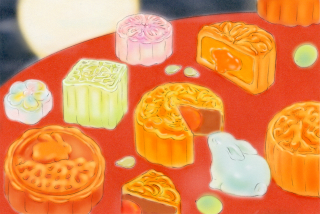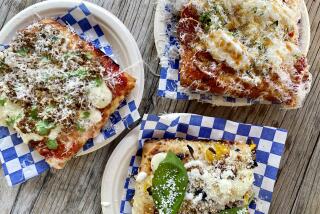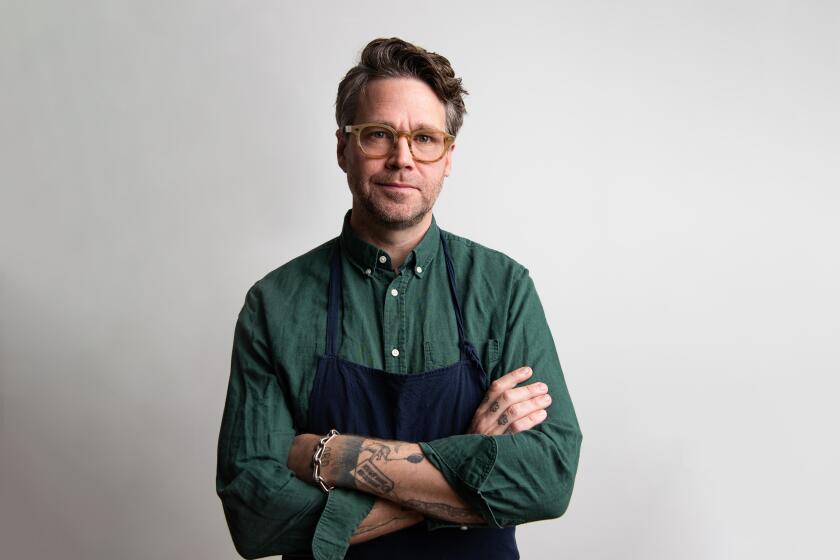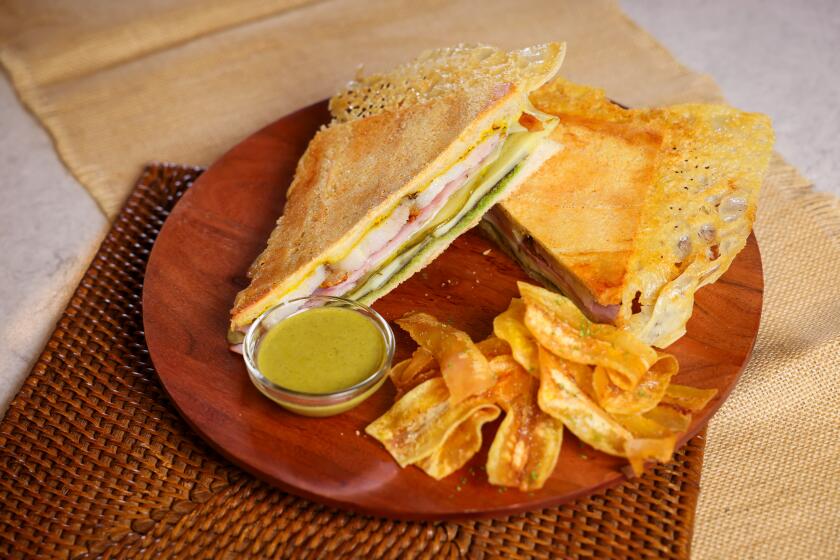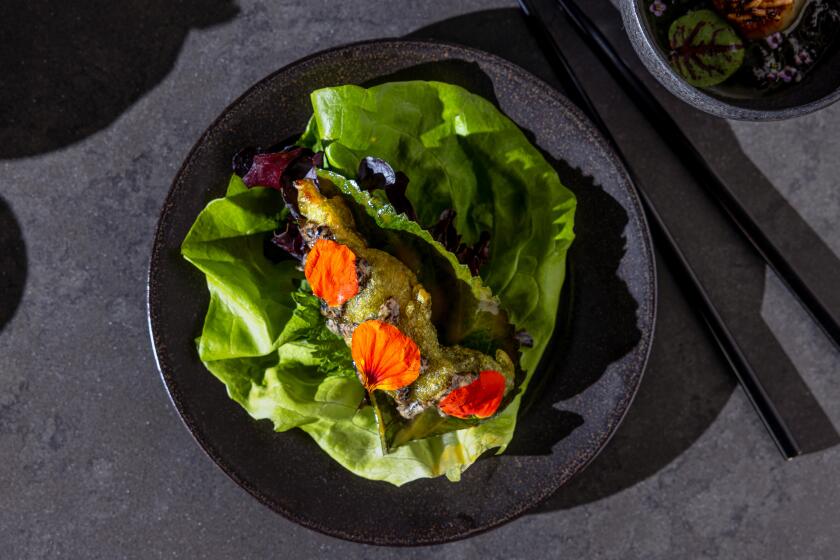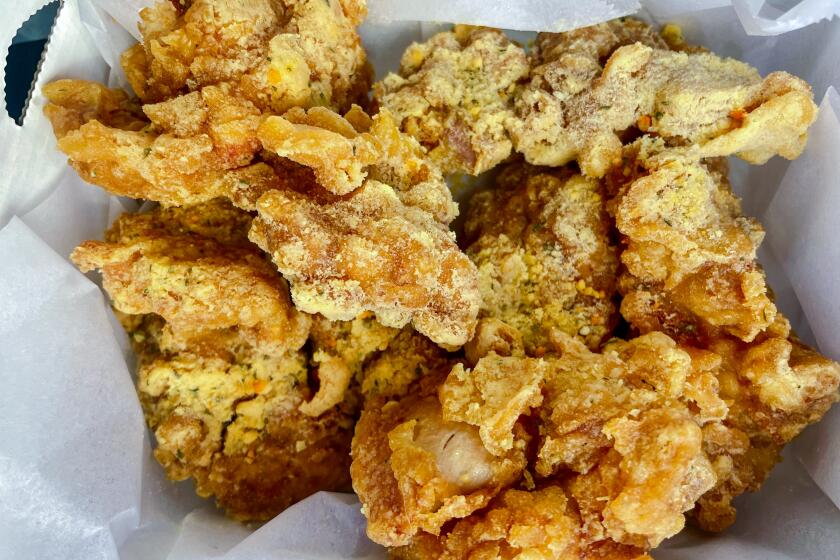The Legacy of L’Ermitage : Cuisine: Even indirectly, you’ve eaten the restaurant’s food. Chef Jean Bertranou may be the father of the American food movement.
When L’Ermitage opened in 1975 it was a restaurant for rich people. When it closed last week it was an institution. Why should you care? Because even if you’ve never been to an expensive restaurant--and have no intention of setting foot inside of one--it changed the way you eat.
When Jean Bertranou opened L’Ermitage, what we all understood to be “good food” was Continental; it relied mainly on meat. “American food,” of course, meant hot dogs and hamburgers and steak. Vegetables were still being called “rabbit food,” and if you went to the supermarket you might find an array of say, 20 or 30 kinds. Fresh herbs were all but unknown. Chasen’s and Perino’s were vying for the title of “Best Restaurant” in Los Angeles, and people who wrote guidebooks were saying things such as: “Los Angeles has not developed much of a distinct regional cuisine.”
“Jean Bertranou,” said Wolfgang Puck, seven years later when he opened Spago, “is the one who showed us what could be done. It was the opening of L’Ermitage that showed that something more was possible in L.A.”
Before L’Ermitage, people in Los Angeles who cooked French food were merely following French recipes. After L’Ermitage, cooks began to understand that French cooking was an attitude, not a formula. Jean Bertranou brought the French spirit into Los Angeles kitchens. If Julia Child enabled people to master the art of French cooking, Jean Bertranou enabled us to master the flavor. He knew that it was impossible to cook good French food without good products. And he discovered that good products were possible here.
Long before Wolfgang Puck was preaching the gospel of freshness, Jean Bertranou had found out that almost anything can be grown in Southern California. When he couldn’t find haricots verts-- the sweet, tiny green beans of France--he simply found someone who would grow them for him. The ducks here didn’t please him--he started a farm. (He smuggled the eggs for his farm into the country by camouflaging them as Easter candies. If asked by the customs inspector what the eggs were, he intended to crack one open and offer it to the inspector to eat. “Remember,” he once said to a friend, “that in my part of France we are all smugglers.”) His ultimate dream, never realized, was to start a still larger farm and raise everything.
What he did raise, however, was a whole generation of young chefs. Half of the talented Americans now working in Southern California kitchens once worked for Jean Bertranou. He taught them more than how to make beurre blanc.
“That was the greatest kitchen I’ve ever worked in,” says Kazuto Matsusaka, now chef at Chinois on Main. “It was such a wonderful place to learn. And not just cooking.” Bertranou’s ultimate lesson was that cooking is more than recipes; it is having the courage to follow your instincts.
And that is why his legacy is so large. Michael McCarty was the first to absorb Bertranou’s lessons and step out on his own. After spending months haunting the kitchen at L’Ermitage he opened Michael’s in 1979; he was the first to actually employ the later-overused term, “California Cuisine.” “We’re serving California food cooked by California chefs,” he boasted--but his very first menu featured “smoked salmon from L’Ermitage.”
Today smoked salmon is commonplace; in those days it was rare. Jean Bertranou was the first chef in Los Angeles to own his own smoker. “He was the first to do everything,” says John Sedlar.
Sedlar himself worked at l’Ermitage for a year and a half and then left to open his own restaurant. At first Saint Estephe was little more than a junior L’Ermitage. But what Sedlar had learned in Bertranou’s kitchen prompted him to go back to his own roots, and before long he was incorporating his grandmother’s dishes into the menu. His first Southwestern menus seemed remarkably daring: In 1982, the very idea of American caviar was radical--the idea of American caviar on blue corn pancakes seemed downright mad. But the food was spectacular, and Saint Estephe became the first in a long line of restaurants featuring Southwestern cuisine. It also was one of the first restaurants in America to showcase what later came to be called “American Regional” cooking. It was not such a giant step from John Sedlar’s chicken with jalapeno chiles to the Santa Fe chicken sandwich with chiles at Carl’s Jr.
Bertranou’s lessons took other chefs into different directions. Using the lessons he had learned, Roy Yamaguchi also went back to his roots--and became one of the first people in the country to start cooking what is now called Franco-Japanese or “Pacific Rim” cooking. “During the years I worked in the kitchen,” he says, “I learned more than I learned anywhere else. But I always knew I had to develop my own style.” Following his own style he combined French techniques with Asian ingredients--and finally with Asian techniques; his Roy’s in Honolulu is now considered to be on the leading edge of Pacific Rim cooking. And Pacific Rim cooking is everywhere: You find it, at popular prices, at restaurants such as Chopstix.
Bertranou also trained a whole generation of pastry chefs: If you’re tired of tarte tatin, blame him for making it so fashionable. Other Bertranou innovations: flourless chocolate cake and that ubiquitous walnut-chocolate torte that you find everywhere, including the corner deli.
But the young chefs who worked for Jean Bertranou did more than just cook food. They talked about it--everywhere. There was a time when you couldn’t turn on your television without finding some young chef showing you how to cook up one of his fancy dishes. Words like cilantro and tomatillo and lemon grass came into the culture and became part of the general vocabulary. As a result, Americans started demanding more--and different--kinds of produce in their markets. Our consumption of chiles doubled; our appetite for variety became insatiable. Supermarkets suddenly found they had to have the products these chefs were using, and before you knew it there was lemon grass at Lucky, exotic mushrooms at Ralphs, haricots verts at Vons.
Am I saying that a French chef was the grandfather of the American food movement? Yes. Because it was the lessons of L’Ermitage that evolved into the food that we now eat.
But L’Ermitage also sowed the seeds of its own destruction. It was a classic French restaurant--very proper, slightly stuffy--serving rather rich food. The chefs who left the kitchen invented a whole new kind of food. Through them we developed a Southern California style of eating--fresh, casual and eclectic. Meanwhile L’Ermitage went on turning out classic French cuisine--and turned into a dinosaur. Had Jean Bertranou lived, his restaurant would probably have changed. Instead his restaurant changed us--and that is why it’s gone.
More to Read
Eat your way across L.A.
Get our weekly Tasting Notes newsletter for reviews, news and more.
You may occasionally receive promotional content from the Los Angeles Times.
